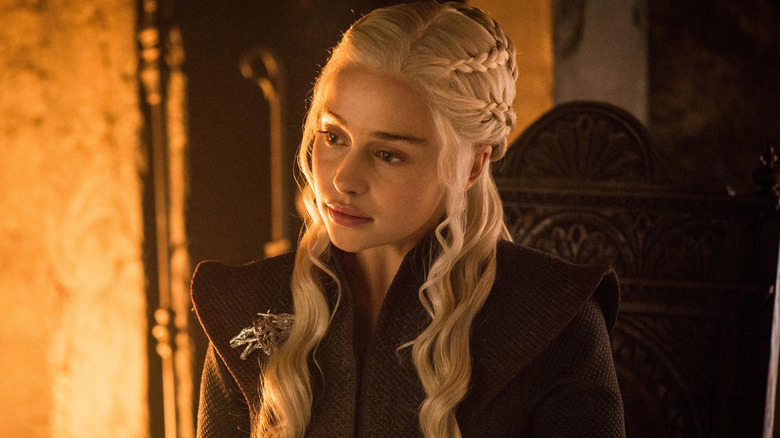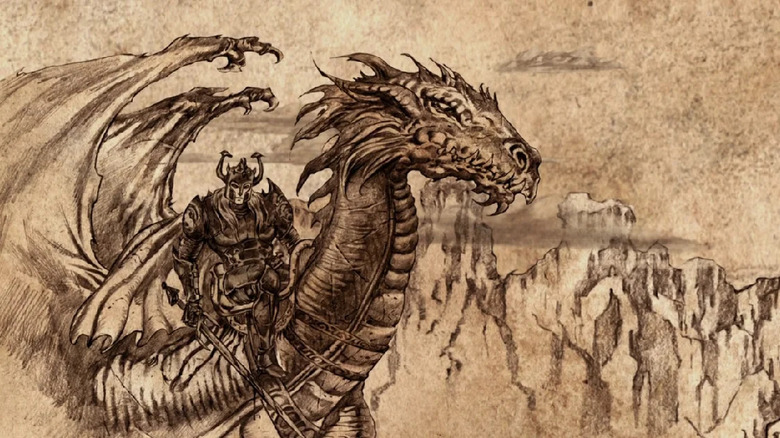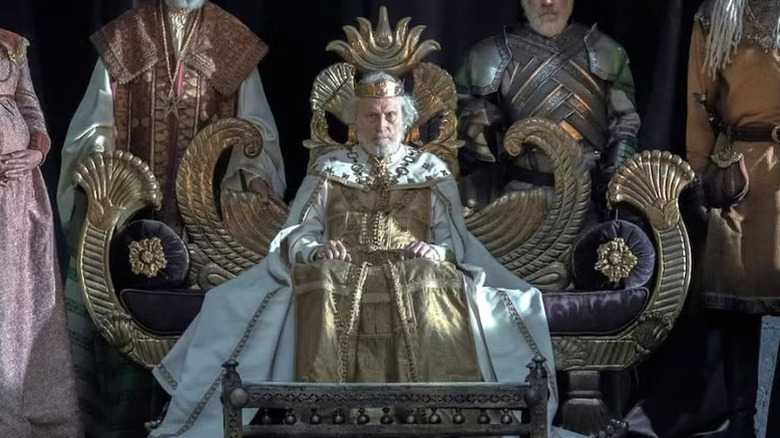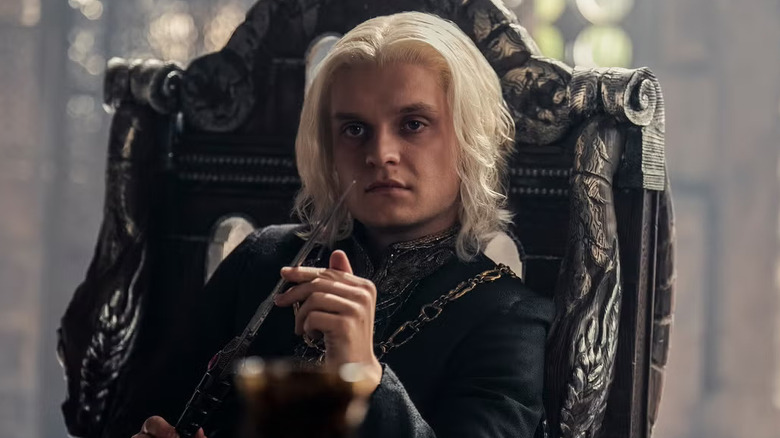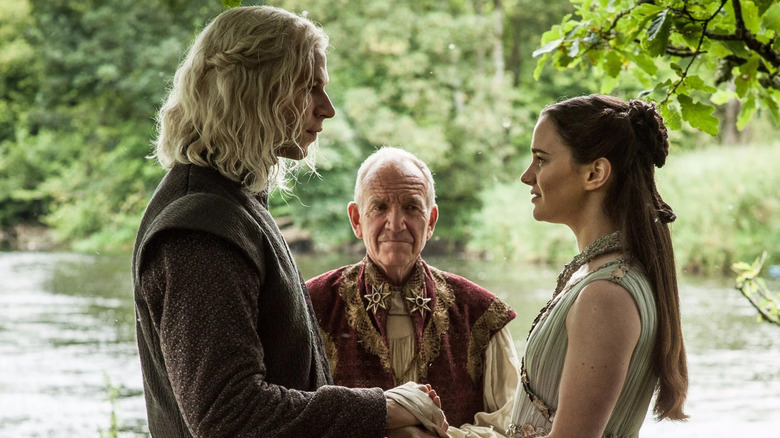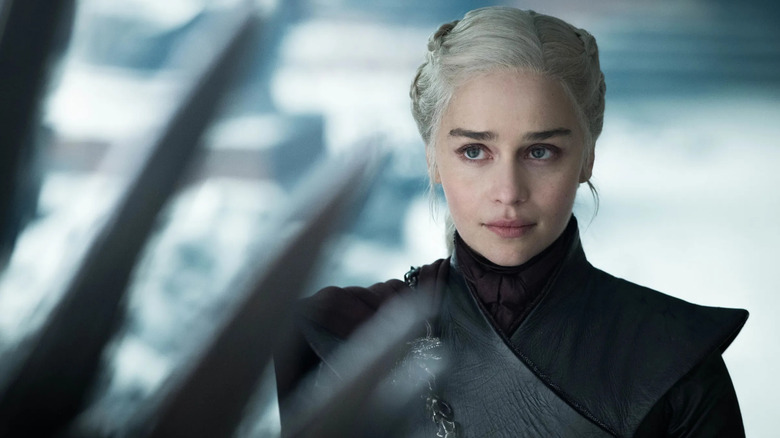Game Of Thrones: The Targaryen Family Tree Explained
TV viewers first met the Targaryens in HBO's "Game of Thrones" and have gone deeper with the silver-haired dragon riders in the saga's prequel series, "House of the Dragon." However, those who've read George R.R. Martin's books know there's a lot more to House Targaryen than you think.
The dynasty's origins date back to the earliest-known history of Martin's fantasy world, predating the life of "Game of Thrones" dragon queen Daenerys Targaryen by several centuries. Like many families in "A Song of Ice & Fire," the exact history of House Targaryen can be difficult to discern. Here's everything you need to know about the Targaryen family tree, including its most important members and how it ends (at least, according to "Game of Thrones.")
The Targaryens hail from Old Valyria
The Targaryens were one of 40 houses that originated from the Valyrian Freehold, an empire in Essos noted for its power over dragons. (Centuries prior to the events of "Game of Thrones," the gigantic beasts were much more common.) While the Targaryens were far from the most powerful of the Valyrian houses, the prophetic visions of Daenys the Dreamer, daughter of Aenar, regarding a cataclysm destroying Valyria led to their self-imposed exile to Westeros, taking up residence on the island of Dragonstone along with their allies of House Velaryon and Celtigar, and several dragons.
Years later, Daenys' visions came true, and an unspecified apocalypse known as "the Doom" completely decimated Valyria and the remaining houses, leaving the Targaryens one of three that survived. Furthermore, the Targaryens were the only dragonriders; their three living dragons were Balerion the Dread, Vhagar, and Meraxes.
Valyria ended up in ruins and remained that way long after House Targaryen's fall and the events of "A Song of Ice and Fire." Eventually, Balerion's rider, Aegon Targaryen, made peace with the most powerful Free Cities in Essos before setting his sights on the rest of Westeros. With his sister-wives Rhaenys (rider of Meraxes) and Visenya (rider of Vhagar), Aegon began his goal of uniting the seven kingdoms into one ruled by a single king, marking the beginning of the centuries-long Targaryen dynasty.
Aegon I conquers Westeros
Aegon's Conquest was the historical event in Westeros that would forever change its history.Over the course of two years, one by one, Aegon took the Stormlands, Westerlands, and the North, after King Torrhen Stark of Winterfell famously bent the knee to Aegon to avoid battle.
The only kingdoms that Aegon was unable to conquer were Dorne and the Iron Islands; for the most part, Westeros was united, and rather than rule his newfound kingdom from the comfort of Dragonstone, Aegon had a city built at the very spot he first landed on the mainland. This area later would be dubbed King's Landing. Aegon also collected the swords of his fallen enemies and melted them down to make the Iron Throne, a symbol of his unrelenting power.
Thus, the remainder of Aegon's rule saw him essentially establishing many future Westerosi traditions, but he continued to set his sights on the still unconquered kingdoms. In his first attempt to claim Dorne, his sister-wife Rhaenys (and her dragon) were shot down from the sky and killed, leaving behind Aegon's eldest son, Aenys. Aegon eventually died, having only fathered one other son, Maegor Targaryen, while Queen Visenya lived through the reigns of the next two Targaryen kings.
Aegon's sons are divisive rulers
Aegon the Conqueror was succeeded by his eldest son Aenys I, who immediately faced uprisings from the Faith of the Seven, who denounced the Targaryens' tendency toward incest and polygamy. They'd forbidden Aenys' half-brother, Maegor, from marrying his own niece, Rhaena; he instead married Ceryse Hightower, who bore Maegor no children. He later had a more fruitful union with Alys Harroway, and was forced into exile by the High Septon.
Uprisings would continue for the next two Targaryen kings, after Aenys fled to Dragonstone and died, making way for his half-brother Maegor to ascend the throne. Maegor, dubbed "the Cruel," reclaimed King's Landing from the Faith and, to secure his own reign, killed Aenys' heir.
The rest of Maegor's reign saw him attempting to secure an heir, marrying a third wife, Tyanna, who also failed to produce him a child. In a desperate attempt to protect his legacy from Aenys' eldest living son, Jaehaerys, Maegor married three wives in one ceremony: Elinor Costayne, Jeyne Westerling, and Aegon's widow, Rhaena Targaryen. Despite naming Rhaena's daughter Aerea as his rightful heir, Maegor was succeeded by King Jaehaerys I Targaryen after his body was found on the Iron Throne with slashed wrists, the exact circumstances of his death unknown.
Jaehaerys I ushers in peacetime
Upon his ascension to the throne following the death of King Maegor, King Jaehaerys I Targaryen was too young to rule, making his mother, Alyssa Velaryon, the Queen Regent for the first two years of his 55-year reign. Rather than provoke the other houses to war, Jaehaerys pardoned those who had committed war crimes under Maegor's rule, but they had to give a son or daughter to the Crown lest they be exiled.
Jaehaerys was unmarried for the early years of his reign, which was not uncommon for his age but which put his potential lineage into question. To avoid another Faith Militant uprising, Queen Alyssa and her husband, Rogar Baratheon, conspired to marry off Jaehaerys' sister, Alysanne. Once Jaehaerys caught wind of this, he fled with Alyssane to Dragonstone and eloped, living there for the remainder of his time as a minor.
The rest of Jaehaerys' reign was prosperous, bearing 13 children and expanding the series of roads throughout Westeros. During this time, Jaehaerys also made peace with the Faith of the Seven, in spite of his incestuous marriage. As those who have seen the "House of the Dragon" premiere know, a major political decision awaited King Jaehaerys near the end of his rule.
The Great Council selects Viserys as Jaehaerys' heir
"House of the Dragon" Season 1 opens on the Great Council of 101, called by King Jaehaerys following the death of his eldest sons. The choice of who should inherit the throne came down to two of his grandchildren: Laenor, the son of Princess Rhaenys, and Viserys, the eldest son of Jaehaerys' second-eldest son, Baelon.
Viserys I Targaryen was selected as his grandfather's heir. Viserys (portrayed in "House of the Dragon" by Paddy Considine) had a peaceful but tragic reign. His wife, Aemma Arryn, bore a daughter: Rhaenyra (played as a youth by Milly Alcock and as an adult by Emma D'arcy), who was chosen to be Viserys' heir after his brother, Daemon Targaryen (played by Matt Smith), mocked Aemma's death by stillbirth.
Viserys remarried, wedding Alicent Hightower (played by Emily Carey and Olivia Cooke), Rhaenyra's childhood friend. Alicent successfully bore Viserys' male heirs, the eldest being Aegon. As Viserys' health steeply declined throughout his reign, the question became whether Rhaenyra or Aegon would claim the throne. Viserys' death left behind a fractured court (Rhaenyra's "blacks" and Alicent's "greens"), sparking a war quicker than news of his death could spread throughout the kingdom.
The Dance of Dragons
Immediately following Viserys' death, Queen Alicent rushed to crown her son, Aegon, as king, while Princess Rhaenyra resided on Dragonstone with her husband/uncle, Daemon, Viserys' former heir. Upon discovering that Aegon sat the Iron Throne, Rhaenyra declared war on her cousin, which was made more personal when Aegon II's brother Aemond slew Rhaenyra's son, Lucerys; in retaliation, Daemon paid an assassin to slaughter Alicent's 6-year-old child.
The so-called "Dance of the Dragons" comprises the bulk of Seasons 1 and 2 of "House of the Dragon" as well as George R.R. Martin's novella "The Princess and the Queen," and (Spoiler Alert!) results in the deaths not only of Daemon and Rhaenyra, but also the lifelong crippling of King Aegon II during the Battle at Rook's Rest. The war also saw the deaths of Princess Rhaenys, Daemon, and many living dragons in Westeros, the last of which eventually died off during the reign of Aegon II's nephew, King Aegon III Targaryen.
By the end of the civil war, the Targaryens remained in power in the Seven Kingdoms. However, the house was forever changed by the losses it suffered. Without the boon of taming and riding dragons, they'd lose a significant amount of control and military prowess over the other Westerosi houses, a heavy consequence of the war that haunted House Targaryen for the remainder of its reign.
Viserys' heirs maintain the Targaryen dynasty
Although the crippled Aegon II ruled for a few months after the Dance of the Dragons ended, he was succeeded by Aegon III, son of Daemon and Rhaenyra. His reign was a time rife with plots to gain political power behind the child king's back.
Ultimately, Aegon III's reign was defined by having to piece together a broken Westeros, struggling with personal bouts of depression, the final extinction of dragons in Westeros, and even a disinterest in consummating his marriage with his wife, Daenaera Velaryon. Nevertheless, their heir King Daeron I Targaryen ascended the throne after Aegon III's reign, though his attempt at conquering Dorne just as Aegon the Conqueror did also resulted in his death.
Daeron was succeeded by his younger brother, King Baelor I Targaryen, who successfully welcomed Dorne into Westeros, finally uniting all Seven Kingdoms. Baelor's successor, King Viserys II, was yet another of Daemon and Rhaenyra's sons, whose reign was successful... prior to his premature death. It was Viserys II's successor that would become one of Westeros' most notorious Targaryen kings thus far.
Aegon V's rule is mired in tragedy
King Aegon IV Targaryen was dubbed "Aegon the Unworthy," given that his behavior on the throne was often callous and misguided. The son of Viserys II, Aegon IV was married to Queen Naerys Targaryen, but had at least nine other mistresses with whom he bore bastards. When he caught a member of his Kingsguard sleeping with one of his mistresses, Bethany Bracken, Aegon had him brutally executed while she watched.
As if there wasn't enough war in the house of the dragon, Aegon IV sowed the seeds for future discord on his deathbed by legitimizing each of his bastard children. Thus, a series of uprisings known as the Blackfyre Rebellions plagued the next few generations of Targaryen kings. Ultimately, the Iron Throne was passed down to King Aegon V, known in his youth as "Egg" while squiring for Ser Duncan the Tall. (The upcoming "Game of Thrones" spin-off "A Knight of the Seven Kingdoms" will follow Egg's adventures with Ser Duncan, AKA "Dunk.")
Aegon V was an ardent opponent of the Targaryen tradition of incestuous marriage, opting to marry Betha Blackwood instead. However, his reign came to an abrupt end with the Tragedy at Summerhall, in which Aegon's attempt to revive dragons resulted in a fire that took his life and those of many others, including Ser Duncan, though the exact details of it are lost to Westerosi history.
The Mad King ends the Targaryen dynasty
Aegon V's successor, King Jaehaerys II, ruled for only three years before leaving the Iron Throne to the most infamous Targaryen of all: King Aerys II, the Mad King. Over the course of his reign, Aerys II slowly descended into insanity, only holding the realm together with the help of his Hand, Tywin Lannister.
With his sister-wife, Rhaella Targaryen, Aerys II bore three children: Prince Rhaegar, who married Elia Martell of Dorne; Prince Viserys; and Princess Daenerys. Prince Rhaegar's abduction of Lyanna Stark, then-betrothed to Robert Baratheon, sparked Robert's Rebellion, a revolt that finally saw all Seven Kingdoms unite against the Mad King. During the Sack of King's Landing, Rhaegar's wife and children were brutally murdered by The Mountain, and Tywin's son, Jaime, slew the Mad King.
Robert Baratheon claimed the Iron Throne for himself, putting an end to the Targaryen dynasty after personally killing Rhaegar at the Battle at the Trident. However, Lyanna was already dead by the war's end, and the Targaryen line had ended ... or so it seemed.
Rhaegar's secret marriage begets Jon Snow
It wasn't until the Season 6 finale of "Game of Thrones" that readers of "A Song of Ice & Fire" were vindicated in their theories about Robert's Rebellion. Contrary to the agreed-upon narrative spread by King Robert Baratheon, Prince Rhaegar and Lyanna Stark actually were in love and eloped. At least as far as the HBO series was concerned, the couple's secret marriage bore a son: Aegon, who, after Lyanna's death during childbirth, was adopted by Ned Stark (Sean Bean), renamed Jon Snow, and explained away as Ned's own bastard son.
Unbeknownst to Jon, he was a living continuation of the Targaryen bloodline, raised alongside the Starks to hide him from Robert's ignorant wrath. At the beginning of "Game of Thrones" and "A Song of Ice & Fire," Jon follows in the footsteps of his uncle Benjen and joins the Night's Watch. Jon eventually becomes the group's Lord Commander until he's removed via mutiny, then later resurrected by the red priestess Melisandre. He later abandons his post to help his half-sister Sansa Stark reclaim Winterfell from the Boltons.
After, Jon is named the King in the North by the houses that've rallied behind the Starks against the Boltons. The post seems to be a far cry from his birthright. But in reality, as his half-brother Bran and former Night's Watchman Samwell Tarly discover, Jon is the Mad King's legitimate heir.
Daenerys becomes a Targaryen ruler in Essos
Whilst the Mad King and Prince Rhaegar were losing the final fights of Robert's Rebellion, Queen Rhaella died giving birth to Daenerys Targaryen on Dragonstone during a massive storm, earning the child the name "Daenerys Stormborn." Daenerys and her older brother, Viserys, were smuggled to Braavos, spending their early years moving among the Free Cities of Essos until they ended up living with Illyrio Mopatis in Pentos. There, Viserys began plotting his re-ascension to the Iron Throne.
As a first step, Viserys sold Daenerys as a bride to Khal Drogo of the Dothraki tribe. On her wedding day, she was gifted three dragon eggs by Illyrio, and also took Westerosi knight Jorah Mormont as her advisor. Against Viserys' plans, Daenerys gains the love of both Drogo and the Dothraki, and Viserys is later executed by Drogo for threatening the Khaleesi and her unborn child.
Sadly, Daenerys' marriage to Drogo was cut short when the Khal dies of an infected wound; Daenerys miscarried soon after. But her decision to throw herself on Khal's funeral pyre doesn't kill her; instead, she survives and Illyrio's eggs hatch among the flames, giving her three newborn dragons she calls her "children." Daenerys becomes known as the "Mother of Dragons" and embarks on a quest of emancipating slaves across Essos, eventually (by the Season 4 finale in "Game of Thrones") taking up residence in the city of Meereen.
Rhaegar's son Aegon may still be alive
Around Season 5 of "Game of Thrones," the books and TV show's stories begin to diverge, with major characters being entirely absent from the series. One such character who's prominent in George R.R. Martin's books but doesn't appear on "Game of Thrones" is someone who completely throws off everything we know about the Targaryen family tree: Young Griff. Tyrion Lannister encounters this blue-haired teenagerwhile en route to Volantis. He learns that the boy is actually named Aegon, and that he — and others — think he is the son of Prince Rhaegar, believed to have been slaughtered by the Mountain.
In the fifth "A Song of Ice & Fire" book, a plot of Targaryen restoration begins to unfold, with the baby having been allegedly smuggled out of King's Landing by Varys and replaced with another child. Aegon plan is to wed Daenerys Targaryen; by the end of "A Dance with Dragons," he's already set foot on Westerosi soil to begin his conquest.
Fortunately for Daenerys (and Jon Snow, to an extent), there's a strong likelihood that Young Griff's identity is a ruse. However, until George R.R. Martin finishes his novel series, the truth will remain elusive.
Game of Thrones reveals the fate of House Targaryen
The final season of "Game of Thrones" is our best indicator of where the family tree of House Targaryen is heading, and it's not very bright. After several seasons ruling Meereen, Daenerys sets her sights on Westeros, reclaiming her birth home of Dragonstone and declaring war against the newly-appointed Queen Cersei Lannister. In Season 7 alone, this war costs Daenerys several integral allies (the Iron Islands and Dorne) and the death of one of her dragons. She also becomes romantically involved with none other than Jon Snow.
However, Daenerys' madness begins after Jon learns of his lineage, making him conflicted regarding his feelings for his girlfriend/biological aunt. Meanwhile, Daenerys' loss of her second of three dragons and continued losses against Queen Cersei send her on a mad rampage toward King's Landing, resulting in her destruction of the city.
Sadly, after finally claiming Aegon the Conqueror's Iron Throne in the series finale, Daenerys is assassinated by Jon before she even gets to sit on it. Jon, as punishment for regicide, is again exiled to the Night's Watch, whose laws of celibacy — if followed — essentially put a true end to the Targaryen bloodline.
